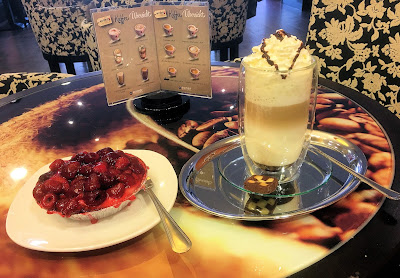Although handicapped with a clubfoot, Joseph was a womanizer, and no starlet became a star without his blessing. His "mountings" soon earned him an alliterated name: Der Bock von Babelsberg (The Babelsberg's ram).
Last year on my way back from Potsdam to Berlin on the S-Bahn, I suddenly read ...
... and got off the train. My intention was not to visit the film studios but rather to explore old Babelsberg. The studios are still operating where the Cold War movie Bridge of Spies was produced recently.
Walking down Karl-Liebknecht-Straße, I took a picture of the town hall. I went in, bought a small brochure about Babelsbergs historische Mitte (Babelsberg's historical center), and felt hungry. Continuing my walk, I passed a restaurant called Domus. Although they announced Babelsberger Küche (Babelsberg cooking), their first dish on the menu was Mexikanischer Feuertopf (Mexican fire pot).
Suddenly my eye caught a café named EXNER fifty meters further down Karl-Liebknecht-Straße. I entered and ordered a Leonardo Light and a raspberry tart. Light means here the opposite of dark.
 |
| 18 February 1943: 14,000 people in Berlin's Sportpalst listen to Joseph Goebbels asking: Wollt ihr den totalen Krieg? (Do you want all-out war?) ©Bundesarchiv |
... and got off the train. My intention was not to visit the film studios but rather to explore old Babelsberg. The studios are still operating where the Cold War movie Bridge of Spies was produced recently.
 |
| Babelsberg's town hall |
Suddenly my eye caught a café named EXNER fifty meters further down Karl-Liebknecht-Straße. I entered and ordered a Leonardo Light and a raspberry tart. Light means here the opposite of dark.
In fact, the coffee pot I ordered was not light at all, being topped with whipped cream and strangely enough decorated as the Leonardo Dark coffee.
While enjoying coffee and cake, I opened the brochure. The first thing I learned was that there is no old Babelsberg, for, until 1938, the place had been called Nowawes, a corruption of Czech Nová Ves, meaning a new village. The Nazis did not like the name because of its Slavic origin and ordered that an existing villa district called Neubabelsberg be combined with old Nowawes to form the town of Babelsberg. How come?
As usual, Frederick the Great did not care what his subjects believed. In 1750 he gave Czech Hussite refugees being spinners and weavers, a new home in Prussia near his residence in Potsdam. When asked how the center of the new colony should look, the king took off his famous tricorne hat and threw it on the table, saying, "Like this!"
Having finished cake and coffee, I walked further up Karl-Liebknecht-Straße, turning right into Lutherstraße, and suddenly He was there, a statue standing in front of the old vicarage holding His Bible out to the otherwise Hussite population.
When I arrived at the triangular Weberplatz (Weaver Square), my visit was tarnished by gusty winds and rain showers.
There is a sculpture of Ioannes Amos Comenius in front of the church. Comenius wrote about himself: By birth, I am a Moravian, my language is Bohemian, and my profession is a theologian. Living through the period of the Thirty Years' War, he, being a Protestant, had to flee Moravia taking exile first in Poland and later in Hungary.
While enjoying coffee and cake, I opened the brochure. The first thing I learned was that there is no old Babelsberg, for, until 1938, the place had been called Nowawes, a corruption of Czech Nová Ves, meaning a new village. The Nazis did not like the name because of its Slavic origin and ordered that an existing villa district called Neubabelsberg be combined with old Nowawes to form the town of Babelsberg. How come?
As usual, Frederick the Great did not care what his subjects believed. In 1750 he gave Czech Hussite refugees being spinners and weavers, a new home in Prussia near his residence in Potsdam. When asked how the center of the new colony should look, the king took off his famous tricorne hat and threw it on the table, saying, "Like this!"
Having finished cake and coffee, I walked further up Karl-Liebknecht-Straße, turning right into Lutherstraße, and suddenly He was there, a statue standing in front of the old vicarage holding His Bible out to the otherwise Hussite population.
 |
| Old vicarage on Lutherstraße |
 |
| A Weberhaus reconstructed in its original style. |
 |
| More weaver houses are used as a restaurant and a wine shop. Note the mulberry tree in the foreground. |
 |
| Friedrichskirche |
There is a sculpture of Ioannes Amos Comenius in front of the church. Comenius wrote about himself: By birth, I am a Moravian, my language is Bohemian, and my profession is a theologian. Living through the period of the Thirty Years' War, he, being a Protestant, had to flee Moravia taking exile first in Poland and later in Hungary.
Comenius is one of the fathers of modern education, demanding primary schooling for boys and girls, including poor and retarded children. Education should be peaceful, friendly, and true to life, leading to independence and individual reasoning. In short: Comenius was an idealist.
This blog is the last in the series describing my November 2015 trip to Berlin and its surroundings.
This blog is the last in the series describing my November 2015 trip to Berlin and its surroundings.
*





No comments:
Post a Comment